- Joined
- Oct 9, 2007
- Messages
- 47,244 (7.55/day)
- Location
- Hyderabad, India
| System Name | RBMK-1000 |
|---|---|
| Processor | AMD Ryzen 7 5700G |
| Motherboard | ASUS ROG Strix B450-E Gaming |
| Cooling | DeepCool Gammax L240 V2 |
| Memory | 2x 8GB G.Skill Sniper X |
| Video Card(s) | Palit GeForce RTX 2080 SUPER GameRock |
| Storage | Western Digital Black NVMe 512GB |
| Display(s) | BenQ 1440p 60 Hz 27-inch |
| Case | Corsair Carbide 100R |
| Audio Device(s) | ASUS SupremeFX S1220A |
| Power Supply | Cooler Master MWE Gold 650W |
| Mouse | ASUS ROG Strix Impact |
| Keyboard | Gamdias Hermes E2 |
| Software | Windows 11 Pro |
Earlier this week, we heard reports of some early adopters of the 4 GB variant of AMD Radeon RX 480 claiming that their cards shipped with 8 GB of memory physically present on their cards, but their graphics card BIOS somehow prevented the GPU from addressing more than 4 GB of it. In its Reddit AMA, the company presented a vague answer to the question of whether such 4 GB cards are moddable to 8 GB by flashing it with the BIOS of the 8 GB variant, by stating that the ability to mod is restricted to review samples. This is both true and false. Short answer: retail 4 GB RX 480 can be flashed to 8 GB, and the modified card perfoms on par with the 8 GB variant.
AMD sent out review samples of the 8 GB variant, and to enable reviews to also put up reviews of the 4 GB variant, it sent a special BIOS that converts the 8 GB card to 4 GB, by reducing its address-space and memory clocks, perfectly simulating the 4 GB variant. AMD's claims of 4 GB cards with 8 GB physical memory being restricted to review samples was proven false when early adopters of retail 4 GB cards discovered eight Samsung 8 Gbit memory chips on their card amounting to 8 GB. We currently have an AIB partner-branded retail 4 GB Radeon RX 480 card which we bought online (invoice posted), and which we're using to prepare our 4 GB RX 480 review. We first discovered that our 4 GB retail card had the same exact Samsung 8x 8 Gb chips (including the same bin, specc'd for 8 Gbps) as the 8 GB card. We flashed this card with the 8 GB card's BIOS, and were successful in doing so. The trick here is to extract the BIOS of the 8 GB card with ATIFlash 2.74 and then transplanting that BIOS onto the 4 GB card. The 8 GB card BIOS image which we used, can be found here. Use at your own risk.
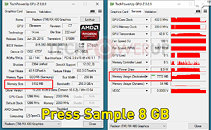
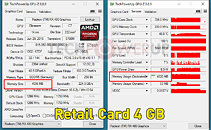
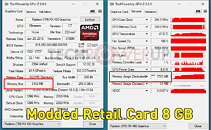
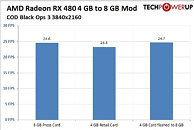
To confirm that this mod works, we first tested our 8 GB review sample with its untouched 8 GB BIOS, and used that as control. Next, we tested the retail 4 GB card with the BIOS it shipped with. Lastly, we flashed this 4 GB card using ATIFlash with the 8 GB BIOS, which we extracted from our 8 GB card using ATIFlash. We ran "Call of Duty: Black Ops III," on the three. This game can consume dedicated video memory beyond 4 GB at 4K Ultra HD (3840 x 2160).
The 8 GB control and the modified 4 GB to 8 GB card performed on-par with each other. The 8 GB control card produced 24.6 fps, the 4 GB to 8 GB modified card produced 24.7 fps. The 4 GB card with its original retail BIOS produced 23.3 fps. To make sure that each GPU runs at a predictable GPU frequency (usually thermal and power limit reduces clocks), we've set both fan and power target to maximum, which results in a constant frequency of 1266 MHz on both cards.
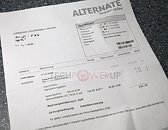
Also, to prove that the game-test (COD: Black Ops III) was able to consume more than 4 GB of video memory on the modified card, as it does on our 8 GB control card, we observed the "Memory Usage (dedicated)" graph of GPU-Z. The modified card was indeed able to address >4 GB of video memory on the card, just as it does on the 8 GB card.
In conclusion, flashing the reference 4 GB Radeon RX 480 to 8 GB works, if you're sure your card has 8 GB of memory physically present. Sadly the only way to know for sure is disassembling your card, which will definitely break some seals and void your warranty. You also need to be sure how to use ATIFlash correctly.
View at TechPowerUp Main Site
AMD sent out review samples of the 8 GB variant, and to enable reviews to also put up reviews of the 4 GB variant, it sent a special BIOS that converts the 8 GB card to 4 GB, by reducing its address-space and memory clocks, perfectly simulating the 4 GB variant. AMD's claims of 4 GB cards with 8 GB physical memory being restricted to review samples was proven false when early adopters of retail 4 GB cards discovered eight Samsung 8 Gbit memory chips on their card amounting to 8 GB. We currently have an AIB partner-branded retail 4 GB Radeon RX 480 card which we bought online (invoice posted), and which we're using to prepare our 4 GB RX 480 review. We first discovered that our 4 GB retail card had the same exact Samsung 8x 8 Gb chips (including the same bin, specc'd for 8 Gbps) as the 8 GB card. We flashed this card with the 8 GB card's BIOS, and were successful in doing so. The trick here is to extract the BIOS of the 8 GB card with ATIFlash 2.74 and then transplanting that BIOS onto the 4 GB card. The 8 GB card BIOS image which we used, can be found here. Use at your own risk.




To confirm that this mod works, we first tested our 8 GB review sample with its untouched 8 GB BIOS, and used that as control. Next, we tested the retail 4 GB card with the BIOS it shipped with. Lastly, we flashed this 4 GB card using ATIFlash with the 8 GB BIOS, which we extracted from our 8 GB card using ATIFlash. We ran "Call of Duty: Black Ops III," on the three. This game can consume dedicated video memory beyond 4 GB at 4K Ultra HD (3840 x 2160).
The 8 GB control and the modified 4 GB to 8 GB card performed on-par with each other. The 8 GB control card produced 24.6 fps, the 4 GB to 8 GB modified card produced 24.7 fps. The 4 GB card with its original retail BIOS produced 23.3 fps. To make sure that each GPU runs at a predictable GPU frequency (usually thermal and power limit reduces clocks), we've set both fan and power target to maximum, which results in a constant frequency of 1266 MHz on both cards.

Also, to prove that the game-test (COD: Black Ops III) was able to consume more than 4 GB of video memory on the modified card, as it does on our 8 GB control card, we observed the "Memory Usage (dedicated)" graph of GPU-Z. The modified card was indeed able to address >4 GB of video memory on the card, just as it does on the 8 GB card.
In conclusion, flashing the reference 4 GB Radeon RX 480 to 8 GB works, if you're sure your card has 8 GB of memory physically present. Sadly the only way to know for sure is disassembling your card, which will definitely break some seals and void your warranty. You also need to be sure how to use ATIFlash correctly.
View at TechPowerUp Main Site












